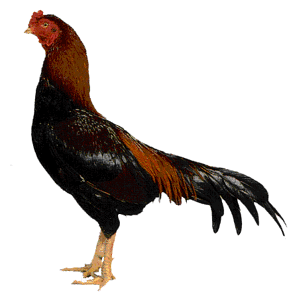

Overview
The Asil chicken, also known as the Aseel chicken is an ancient breed originating in India. Asil Chickens are probably the oldest known breed of game fowl, having been bred for its fighting qualities for over 2000 years. The name Asil is derived from Arabic and means ‘of long pedigree’. In different dialects it can be spelled Asil, Aseel or Asli.
In its native land the Asil Chicken was bred to fight, not with false spurs, but rather with its natural spurs covered with tape, the fight being a trial of strength and endurance. This style of fighting produced a powerful and muscular bird with a strong beak, thick muscular neck and powerful legs, together with a pugnacious temperament and stubborn refusal to accept defeat.
Asil chickens have never been very numerous in Britain or the U.S but that has nevertheless always attracted a few dedicated admirers prepared to cope with its inborn desire to fight, a characteristic shared by the females who are poor layers but extremely good mothers.
Female Asils weigh an average of 5.1lbs (2.3kg) and males weigh 8.4lbs (3.8kg).
Eggs
Size
Small eggs
Color
Light brown
Production per year
40 eggs per annum
When do they start laying eggs?
From 7 months
Asil Characteristics
Temperament / Are they good as pets?
Despite being fighter birds, Asil chickens are very friendly towards humans and they’re easy to tame. These chickens make for good mothers but are not good egg layers. They do best in warmer climates so they shouldn’t be kept in countries with cold winters. They also need lots of space so would not be good as backyard pets.
How do I tame Asil chickens?
Asil chickens are very trusting of humans which means they’re easier to tame. Handle the birds when they’re young so that they become used to human contact. You can also try feeding the birds from your hand.
How many do I need to buy?
Chickens are happiest with friends and therefore, at an absolute minimum you should have two chickens, but it is best to have at least six. Don’t get too many chickens as larger flocks mean more fights which can often result in chickens being killed.
How much space do they need?
Due to their love of fighting, these birds need more space than your average breed. At least 1.3 or 15 square feet is needed in the coop per chicken. Their roaming space needs to be 250 square feet each at a very minimum, however much more would be suggested as more space will allow for less fights.
Will they mix with my other chickens?
These chickens should not be mixed with others due to their love of fighting that starts from an early age.
Appearance
Asil chickens are muscular birds with multicolored plumage, which is mainly dark brown or black. They have long tails, small red earlobes and a red pea comb.
Feeding
What should I feed them?
When you first get your chicks you should feed them growers mash until they’re 6 weeks. Growers mash is a smaller form of chicken feed that has a high protein content (19{cfcd481556a8b43fba6af451761032bd323e94372a0c1e607}) that aids them with development.
Once they reach 6 weeks you can switch them to chicken pellets which is just chicken feed in pellet form with a 15-16{cfcd481556a8b43fba6af451761032bd323e94372a0c1e607} protein content.
At 18 weeks gradually switch your chickens to layers pellets or mash. This chicken feed has around 16{cfcd481556a8b43fba6af451761032bd323e94372a0c1e607} protein and is filled with all the good stuff your chickens need to help them with egg production.
How much should I feed them?
Chickens eat between 2.9 oz (80g) to 4.2 oz (120g) daily, the average bird will eat ¼ a pound (113g). Try feeding your chickens the average amount and then adjust according to their consumption. You can either feed the morning and evening or, if you like, you can leave chicken feed in the feeder for them to nibble on the whole day.
What can’t they eat?
In the UK it is illegal to feed your chickens scraps from the kitchen as it runs the risk of carrying diseases. Moldy food should also not be fed to your chickens as the mold can cause all sorts of health problems.
Chocolate and beans are the two main foods that should never be fed to chickens. Chocolate contains theobromine which can induce heart problems in chickens and lead to fatalities.
Beans have phytohemagglutinin in which also leads to fatalities in chickens. Make sure that there are no bean plants near the chicken coop so that your birds can’t get a hold of any.
What do I need to keep chickens?
The most important piece of equipment needed for keeping chickens is a chicken coop. The coop needs to have 1.3 sqft per chicken or 15 square feet at a minimum. Don’t have the coop too big otherwise they’ll have problems keeping it warm.
Your chickens will need a little perch to sleep on at night and also some wooden nesting boxes filled with wood shavings. You’ll need some extra outdoor space for them to cruise about in that should about to at least 250 square feet per bird.
You’ll need a fence to keep your chickens safe at night from predators that should be sunk at least 8 inches into the ground and goes around and over the whole of the coop. Chickens need access to water at all times, they prefer cold water so keep the container away from sun rays. Get a container which can’t be knocked over or stood in.
Grit is very important when making eggs so make sure there is always some near that they can help themselves to it.
